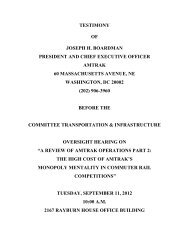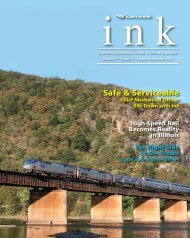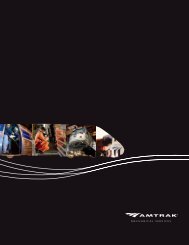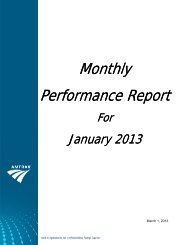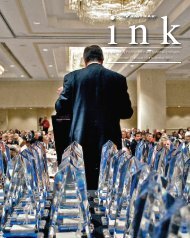May 2011 - Amtrak
May 2011 - Amtrak
May 2011 - Amtrak
You also want an ePaper? Increase the reach of your titles
YUMPU automatically turns print PDFs into web optimized ePapers that Google loves.
$2,600. Repairing and refurbishing a used equalizer at the shop, by<br />
contrast, costs about $234. Over the course of a 12-month period,<br />
this translates into a cost savings of $161,800 over the cost to purchase<br />
new equalizers.<br />
The facility started buying equalizers because the shop could not<br />
keep pace with truck production. Recent efforts to realign labor<br />
resources, however, have enabled the shop to reduce the pool of<br />
unusable equalizers, with the long-term goal of eliminating new<br />
purchases.<br />
Steve Stone, local leader for the International Brotherhood of<br />
Boilermakers and Blacksmiths (IBB) and a boilermaker and<br />
welder at Beech Grove for 37 years, says the proposal to refurbish<br />
the equipment came about as a direct result of recent union and<br />
management talks.<br />
“I’m a union man myself,” he says. “But we’ve really gotten<br />
together with management on how we can save money.”<br />
The recent collaboration has required a change in mindset<br />
among all players, says John Grey, the superintendent at Beech<br />
Grove.<br />
After the trip to American Airlines’ mechanical operations, he<br />
says, union and management leaders got together, “and we had a<br />
really tough session,” says Grey. “Everyone got things off their<br />
Marisol Mejia Prince joined the Beech<br />
Grove mechanical facility’s staff in April,<br />
filling the newly created role of process engineer.<br />
Prior to coming to<br />
<strong>Amtrak</strong>, she worked as a<br />
foreman and management<br />
expert in the manufacturing<br />
and automotive industries.<br />
Here, she talks about how<br />
she’s approaching the job<br />
and explains what the management-strategy<br />
terms Six<br />
Sigma and “lean manufacturing”<br />
really mean.<br />
Q: How would you describe<br />
your role?<br />
A: A lot of what process engineering is<br />
about is taking something existing, like a<br />
process, and looking at it with a fresh pair of<br />
eyes.<br />
One of the things that has driven me in<br />
engineering and the different jobs I’ve had<br />
is looking at a problem and working with<br />
different people to solve it. I’ve always<br />
believed the answers to most manufacturing-related<br />
problems are already out there.<br />
The people who are working on the product<br />
already have the solution. And they’re just<br />
looking for a little encouragement or<br />
support to implement answers they already<br />
Marisol Mejia Prince<br />
have.<br />
I’ve seen work I’ve done get outsourced<br />
overseas, and I’ve lost my job and been laid<br />
off because of it. And so I look<br />
for every chance I can get to keep<br />
work here that we can do successfully<br />
here.<br />
Q: What are the challenges and<br />
opportunities for Beech Grove?<br />
A: Well, we have an older facility.<br />
And related to that, the work<br />
flow is not always laid out in a<br />
way that’s most efficient.<br />
So the challenge is, how do we<br />
break out of the mindset that<br />
that’s just the way things are?<br />
The employees here do a very good job of<br />
working around challenges. But how do we<br />
eliminate problems so that they don’t have<br />
to work around them? How do we get<br />
ahead of them?<br />
One of the areas we can improve on is<br />
finding better ways to share information.<br />
We need a more central system so that<br />
someone in Trim shop (the end of the<br />
process) can easily know when we’ll be<br />
pulling in a certain car into Coach 1 (the<br />
beginning of the process). And then they<br />
can start planning accordingly.<br />
Now, obviously the specific timing<br />
depends on a lot of things that happen<br />
<strong>Amtrak</strong> Ink <strong>May</strong> <strong>2011</strong> | 11<br />
chest. And then we said, Ok, let’s put the past behind us and move<br />
forward.”<br />
Grey says he gives a lot of credit to the local union chairmen.<br />
“They’ve really stepped up to the plate.” At his request, the unions<br />
now even run the weekly meetings in Beech Grove to plan the<br />
future of the shop.<br />
A new culture of cooperation has also taken hold in Delaware,<br />
says Frank Gentry, president of the local International Brotherhood<br />
of Electrical Workers (IBEW), which covers Bear and Wilmington.<br />
“Lew Wood [superintendent at Bear] and Bob Costello [superintendent<br />
at Wilmington] come to us frequently, and we often bring<br />
issues to them,” says Gentry. “That kind of communication is what<br />
will help ensure our future.”<br />
Gentry says the addition of new employees has also added<br />
energy to the shops. “They want to know they’ll have a job 20 years<br />
from now,” he says.<br />
Other examples of recent cost savings include the $17,000 a year<br />
the company is no longer spending since the Wilmington facility<br />
took over the servicing of fire extinguishers for Northeast Corridor<br />
electric locomotives and coaches.<br />
continued on page 12<br />
during the process. But just having that<br />
information easily accessible can help<br />
people plan better. It lets them know where<br />
they need to start focusing their priorities.<br />
Q: What’s behind the strategies?<br />
A: Strategies such as Six Sigma and “lean<br />
manufacturing” are sometimes misunderstood,<br />
and they can be applied incorrectly.<br />
It’s really about giving people the tools<br />
and materials they need to do their job<br />
more efficiently. I know it’s cliché, but it<br />
really is about working smarter, not harder.<br />
It’s finding ways to reduce and hopefully<br />
eliminate waste in terms of bad parts or<br />
having to rework something because of bad<br />
information or having to move materials in<br />
and out of a station because of a mistake<br />
made somewhere along the line. It’s about<br />
better workflow.<br />
That’s what allows people to get more<br />
done in less time and more efficiently.<br />
That’s what we can do to improve business<br />
at Beech Grove without having to wait for<br />
increases in budget.<br />
The important thing to remember is that<br />
it’s a very competitive market out there, and<br />
everyone should know that the world is<br />
changing, business is changing. And because<br />
of that we have to change, too. It doesn’t<br />
have to be painful. It doesn’t have to be<br />
frightening. We control our own destiny. ■







